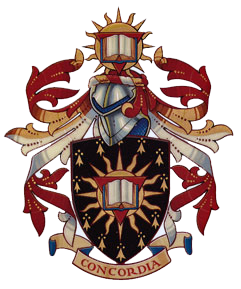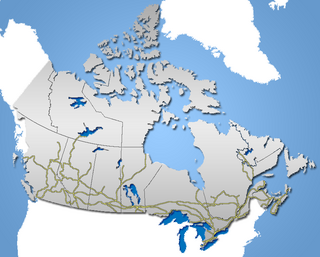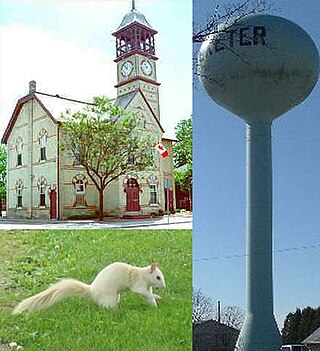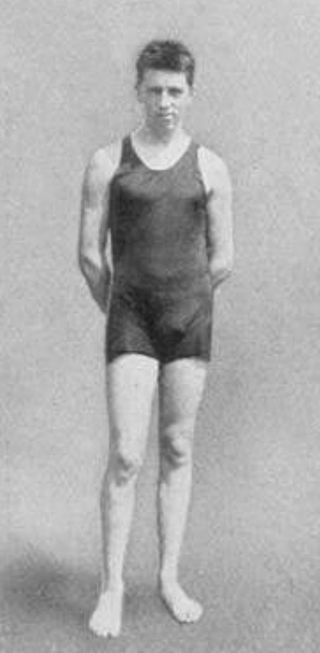
Canada, the world's second-largest country in total area, is dedicated to having an efficient, high-capacity multimodal transportation spanning often vast distances between natural resource extraction sites, agricultural and urban areas. Canada's transportation system includes more than 1,400,000 kilometres (870,000 mi) of roads, 10 major international airports, 300 smaller airports, 72,093 km (44,797 mi) of functioning railway track, and more than 300 commercial ports and harbours that provide access to the Pacific, Atlantic and Arctic oceans as well as the Great Lakes and the St. Lawrence Seaway. In 2005, the transportation sector made up 4.2% of Canada's GDP, compared to 3.7% for Canada's mining and oil and gas extraction industries.

Hamilton is a port city in the Canadian province of Ontario. Hamilton has a population of 569,353 (2021), and its census metropolitan area, which encompasses Burlington and Grimsby, has a population of 785,184. The city is situated approximately 45 kilometres (28 mi) southwest of Toronto in the Greater Toronto and Hamilton Area (GTHA).

The National Hockey League (NHL); French: Ligue nationale de hockey (LNH), is a professional ice hockey league in North America consisting of 32 teams – 25 in the United States and 7 in Canada. The Stanley Cup, the oldest professional sports trophy in North America, is awarded annually to the league playoff champion at the end of each season. The NHL is one of the major professional sports leagues in the United States and Canada and is considered to be the top-ranked professional ice hockey league in the world, with players from 17 countries as of the 2023–24 season. The International Ice Hockey Federation (IIHF) also views the Stanley Cup as one of the "most important championships available to the sport". The NHL is headquartered in Midtown Manhattan.

Concordia University is a public English-language research university located in Montreal, Quebec, Canada. Founded in 1974 following the merger of Loyola College and Sir George Williams University, Concordia is one of the three universities in Quebec where English is the primary language of instruction. As of the 2022–23 academic year, there were 49,898 students enrolled in credit and non-credit courses at Concordia, making the university among the largest in Canada by enrollment. The university has two campuses, set approximately seven kilometres apart: Sir George Williams Campus is the main campus, located in the Quartier Concordia neighbourhood of Downtown Montreal in the borough of Ville Marie; and Loyola Campus in the residential district of Notre-Dame-de-Grâce. With four faculties, a school of graduate studies and numerous colleges, centres and institutes, Concordia offers over 400 undergraduate and over 120 graduate programs and courses.

The Hockey Hall of Fame is a museum and hall of fame located in Toronto, Ontario, Canada. Dedicated to the history of ice hockey, it holds exhibits about players, teams, National Hockey League (NHL) records, memorabilia and NHL trophies, including the Stanley Cup. Founded in Kingston, Ontario, the Hockey Hall of Fame was established in 1943 under the leadership of James T. Sutherland. The first class of honoured members was inducted in 1945, before the Hall of Fame had a permanent location. It moved to Toronto in 1958 after the NHL withdrew its support for the International Hockey Hall of Fame in Kingston, Ontario, due to funding issues. Its first permanent building opened at Exhibition Place in 1961. The hall was relocated in 1993, and is now in Downtown Toronto, inside Brookfield Place, and a historic Bank of Montreal building. The Hockey Hall of Fame has hosted International Ice Hockey Federation (IIHF) exhibits and the IIHF Hall of Fame since 1998.

The Mann Cup is the trophy awarded to the senior men's box lacrosse champions of Canada. The championship is a best-of-seven, East vs West series played between the league champions of Major Series Lacrosse, the East, and Western Lacrosse Association, the West.

Black Canadians, also known as African Canadians or Afro-Canadians, are Canadians of full or partial sub-Saharan African descent.

Canada has a large and well-developed railway system that primarily transports freight. There are two major publicly traded transcontinental freight railway systems, Canadian National (CN) and Canadian Pacific Kansas City (CPKC). Nationwide passenger services are provided by the federal crown corporation Via Rail, and three international services to the US by Amtrak. Three Canadian cities have commuter train services: in the Montreal area by Exo, in the Toronto area by GO Transit, and in the Vancouver area by West Coast Express. These cities and several others are also served by light rail or metro systems. Only one (Toronto) has an extensive streetcar (tram) system. Smaller railways such as Ontario Northland Railway also run passenger trains to remote rural areas. The Rocky Mountaineer and Royal Canadian Pacific provide luxury rail tours for viewing scenery in the Canadian Rockies as well as other mountainous areas of British Columbia and Alberta.

Dwayne Anthony De Rosario OOnt is a Canadian former professional soccer player, who played as a forward or as an attacking midfielder. A versatile attacker, he played for the Toronto Lynx, FSV Zwickau and Richmond Kickers early in his career. He came to prominence in the 2000s playing in Major League Soccer for the San Jose Earthquakes, Houston Dynamo, Toronto FC, New York Red Bulls and D.C. United. A four-time MLS Cup champion, he also won the 2011 MLS Most Valuable Player award. He is the ninth-leading scorer in MLS history with 104 goals. He is widely regarded as one of the greatest and most decorated Canadian players of all time.
The Canadian Motorsport Hall of Fame (CMHF) is a hall of fame run by the Canadian Motorsport Heritage Foundation as a not-for-profit charitable institution that "honours and recognizes the achievements of individuals and institutions that have made outstanding contributions to Canadian motorsport as drivers, owners, team members, motorsport builders, sponsors and significant contributors, as well as those who have distinguished themselves in the new Media category." It was established in 1992 by Gary Magwood and Lee Abrahamson, with assistance by Automobile Journalists Association of Canada founding president and motorsport reporter Len Coates, to celebrate the accomplishments and contributions of the various Canadian motorsports communities. The CMHF has moved location six times over the course of its history due to difficulties garnering sponsorship and community support creating financial trouble, and has been housed at The Canadian Motorsport Heritage Museum, in Toronto's Downsview Park since 2010.

Canada's Sports Hall of Fame is a Canadian sports hall of fame and museum in Calgary, Alberta, Canada. Dedicated to the history of sports in Canada, it serves as a hall of fame and museum for accomplished Canadian athletes, and sports builders and officials.

Exeter is a community in the municipality of South Huron, in the southern portion of Huron County, Ontario, Canada, located approximately 40 kilometres north of London. The community proclaims itself the "Home of the White Squirrel", owing to the presence of the unusually-coloured mammals. Exeter's mascot, "Willis The White Wonder", can be seen at many community events throughout the year, including Canada Day celebrations, the Exeter Rodeo, and the Santa Claus Parade.

George Ritchie Hodgson was a Canadian competition swimmer of the early 20th century, and considered by many to be the greatest swimmer in Canadian history. Hodgson won the two longer freestyle swimming gold medals at the 1912 Olympics, the only categories in which he competed. He also competed at the 1920 Summer Olympics.
Joseph Benjamin Keeper was a Canadian long-distance runner, and a member of the 1912 Canadian Olympic team.

The first instances of organized women's ice hockey in Canada date back to the 1890s when it was played at the university level. The Women's Hockey Association claims that the city of Ottawa, Ontario hosted the first game in 1891. In 1920, Lady Meredith, an avid sportswoman and wife of Sir Vincent Meredith of Montreal donated the Lady Meredith Cup to the Quebec Ladies' Hockey Association, said to be the first women's ice hockey trophy created for a competition in Canada. At the time women competed in ankle-length skirts.

The Alberta Pandas ice hockey team represents the University of Alberta in the Canada West Universities Athletic Association of U Sports. The team was led by head coach Howie Draper from 1997 until 2023, when Draper left to become head coach of PWHL New York. The current head coach is Darren Bilawchuk. The program has won the most Canada West conference championships with 14 and the most U Sports national championships with eight.
Ray Fletcher Farquharson was a Canadian medical doctor, university professor, and medical researcher. Born in Claude, Ontario, he attended and taught at the University of Toronto for most of his life, and was trained and employed at Toronto General Hospital. With co-researcher Arthur Squires, Farquharson was responsible for the discovery of the Farquharson phenomenon, an important principle of endocrinology, which is that administering external hormones suppresses the natural production of that hormone.
Racism in Canada traces both historical and contemporary racist community attitudes, as well as governmental negligence and political non-compliance with United Nations human rights standards and incidents in Canada. Contemporary Canada is the product of indigenous First Nations combined with multiple waves of immigration, predominantly from Europe and in modern times, from Asia.
Terry Jones, nicknamed Large or Jonesy, is a Canadian journalist and author based in Edmonton, Alberta. He is currently a sports columnist with the Edmonton Sun.

The Ontario Sports Hall of Fame is an association dedicated to honouring athletes and personalities with outstanding achievement in sports in Ontario, Canada. The hall of fame was established in 1994 by Bruce Prentice, following his 15-year tenure as founder and president of the Canadian Baseball Hall of Fame (CBHF). The inaugural class of honoured members was inducted in 1994.
















